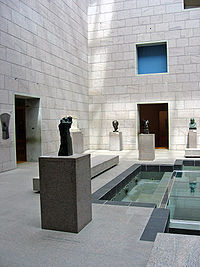
Photo from wikipedia
Introduction Arts and cultural engagement are associated with a range of mental and physical health benefits, including promoting heathy aging and lower incidence of age-related disabilities such as slower cognitive… Click to show full abstract
Introduction Arts and cultural engagement are associated with a range of mental and physical health benefits, including promoting heathy aging and lower incidence of age-related disabilities such as slower cognitive decline and slower progression of frailty. This suggests arts engagement constitutes health-promoting behaviour in older age. However, there are no large-scale studies examining how the predictors of arts engagement vary with age. Methods Data from the Health and Retirement Study (2014) were used to identify sociodemographic, life satisfaction, social, and arts appreciation predictors of (1) frequency of arts engagement, (2) cultural attendance, (3) difficulty participating in the arts, and (4) being an interested non-attendee of cultural events. Logistic regression models were stratified by age groups [50–59, 60–69, ≥70] for the frequency of arts participation outcome and [50–69 vs ≥70] all other outcomes. Results Findings indicated a number of age-related predictors of frequent arts engagement, including gender, educational attainment, wealth, dissatisfaction with aging, and instrumental activities of daily living (iADL). For cultural event attendance, lower interest in the arts predicted lack of engagement across age groups, whereas higher educational attainment and more frequent religious service attendance became predictors in older age groups (≥ 70). Adults in both age groups were less likely to report difficulties engaging in the arts if they had lower neighbourhood safety, whilst poor self-rated health and low arts appreciation also predicted reduced likelihood of this outcome, but only in the younger (50–69) age group. Adults in the older (≥ 70) age group were more likely to be interested non-attendees of cultural events if they had higher educational attainment and less likely if they lived in neighbourhoods with low levels of safety. Conclusions Our results suggest that certain factors become stronger predictors of arts and cultural engagement and barriers to engagement as people age. Further, there appear to be socioeconomic inequalities in engagement that may increase in older ages, with arts activities overall more accessible as individuals age compared to cultural engagement due to additional financial barriers and transportation barriers. Ensuring that these activities are accessible to people of all ages will allow older adults to benefit from the range of health outcomes gained from arts and cultural engagement.
Journal Title: PLoS ONE
Year Published: 2021
Link to full text (if available)
Share on Social Media: Sign Up to like & get
recommendations!